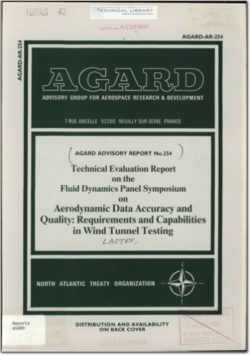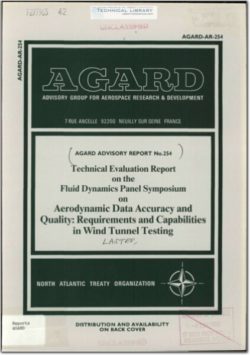AGARD-AR-254

- Version
- 211 Downloads
- 4.67 MB File Size
- 1 File Count
- March 8, 2016 Create Date
- March 8, 2016 Last Updated
Aerodynamic Data Accuracy and Quality - Requirements and Capabilities in Wind Tunnel Testing

The terminology used throughout the sym osium by various authors was troublesome and
sometimes inconsistent between papers, which led to con usion in the discussion of the overall subject of
“accuracy.” The words accuracy, error, data repeatability, uncertainty, precision, etc. were repeatedly used
but there was little uniformity in the use of the terms. For example, quite often the term "accuracy“ was
used to mean precision uncertainty and at other times it indicated total uncertainty as well as repeatability.
The propulsion test community has adopted a reasonably consistent terminology. Perhaps the wind tunnel
community could adopt the same terminology or at least an attempt should be made to use a consistent set
of terminolo y. Three papers were noted to use consistent terminology, i.e. references 5, 7, and 8. These
terms basical y are uncertainty, bias, and precision. The total uncertainty is defined to be made up of bias
and precision terms. The same references used a similar math model to calculate bias and precision which
also serves an excellent basis for comparing data uncertainty.
Most papers presented in the s mposium dealt with data taken from low speed and transonic wind
tunnels. One pa er addressed pro lems with hypersonic Mach number characterization. The session on
requirements, re erences 31 - 34, presented excellent discussions of goals to achieve in wind tunnel testing.
As was pointed out by Krenz, Reference 31, current day aircraft, especially transport aircraft, can rel on
“reference methods' to design aircraft. Reference methods have proven to work very well. T ey.
however,do depend upon a well substantiated data base (from developed aircraft) which generall exists for
subsonic and transonic transport aircraft. Reference methods have proven reliable using ata from
conventional wind tunnels for small configuration changes. Whenever a baseline of data does not exist
”direct scaling)" techniques must be employed.
| File | Action |
|---|---|
| AGARD-AR-254 Aerodynamic Data Accuracy and Quality - Requirements and Capabilities in Wind Tunnel Testing.pdf | Download |

Comment On This Post